East Coast of the United States
The East Coast of the United States, also known as the Eastern Seaboard, the Atlantic Coast, and the Atlantic Seaboard, is the region encompassing the coastline where the Eastern United States meets the Atlantic Ocean.
East Coast of the United States | |
|---|---|
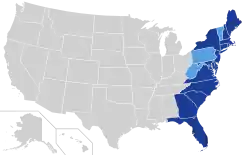 The East Coast of the United States. States with a coastline on the Atlantic Ocean are highlighted in dark blue. States considered part of the East Coast without a coastline are highlighted in light blue. | |
| Country | |
| Principal cities | Boston Providence Hartford New York City Newark Philadelphia Baltimore Washington, D.C. Richmond Virginia Beach Raleigh Charlotte Charleston Atlanta Jacksonville Orlando Tampa Miami |
| Largest city | New York City |
| Largest metropolitan area | New York metropolitan area |
| Population (2017 estimate) | |
| • Total | 118,042,627[1] |
| Time zone | UTC−05:00 (Eastern) |
| • Summer (DST) | UTC−04:00 (EDT) |
The region is generally understood to include the U.S. states that border the Atlantic Ocean: Connecticut, Delaware, Florida, Georgia, Maine, Maryland, Massachusetts, New Hampshire, New Jersey, New York, North Carolina, Rhode Island, South Carolina, and Virginia, as well as the federal capital of Washington, D.C., and non-coastline states: Pennsylvania, Vermont, and West Virginia.[2]
Toponymy and composition
The place name East Coast derives from the idea that the contiguous 48 states are defined by two major coastlines, one at the western edge and one on the eastern edge. Other terms for referring to this area include the Eastern Seaboard, which is another term for coastline,[3] Atlantic Coast, and Atlantic Seaboard because the coastline lies along the Atlantic Ocean.
The 14 states that have a shoreline on the Atlantic Ocean are (from north to south): Maine, New Hampshire, Massachusetts, Rhode Island, Connecticut, New York, New Jersey, Delaware, Maryland, Virginia, North Carolina, South Carolina, Georgia, and Florida.[4] Pennsylvania and Washington, D.C. border the Delaware River and the Potomac River, respectively, both of which are tidal arms of the Atlantic Ocean.
Colonial history
The original Thirteen Colonies of Great Britain in North America all lay along the East Coast.[lower-alpha 1]
Two additional U.S. states on the East Coast were not among the original Thirteen Colonies: Maine became part of the English Colony of Massachusetts in 1677[5] and Florida was held by the British from the end of the French and Indian War until 1781 and was part of New Spain until 1821.
In present-day Florida, Spanish explorer Juan Ponce de León made the first textual records of the state during his 1513 voyage. The state was initially named for Ponce de Ponce de León, who called the peninsula La Pascua Florida in recognition of the verdant landscape and because it was the Easter season.[6]
Delaware Colony and the provinces of New Jersey, New York, and Pennsylvania had been colonized by the Dutch as New Netherland until they were ceded to the British in the mid- to late-17th century.
Geography and climate



Three basic climate regions occur on the East Coast according to the Köppen climate classification and four occur according to the Trewartha climate classification from north to south based on the monthly mean temperature of the coldest month (January) and the number of months averaging above 50°F (10°C), respectively:.
The region from northern Maine and Upstate New York south to most of Connecticut, most of northern New Jersey, most of Pennsylvania, and western Maryland has a humid continental climate (Dfa/Dfb/Dc), with warm-to-hot summers, cold and snowy winters with at least one month averaging below freezing, and four to seven months with mean temperatures warmer than 50°F
The area from Martha's Vineyard and extreme SW Rhode Island to southern Delaware and western North Carolina has a warm temperate climate (Cfa Köppen/Do Trewartha) with long and hot summers with at least one month over 22°C (71.6°F), cool winters with all months over freezing, and six to seven months above 50°F. Although winter precipitation is more likely to fall as rain than as snow, occasional heavy snow is possible.
The area from the southern Delmarva Peninsula, southeast Virginia, and central North Carolina south to central Florida is subtropical (Cfa/Cf), with hot and rainy summers, mild and drier winters, and eight to twelve months above 50°F. Urban heat island exclaves of this zone are found north of this area in Baltimore and Washington, D.C.
The region of Florida from the south-central region of the state south to the Florida Keys has a tropical climate (Af/Aw/Ar) that is frost-free, warm to hot all year, and each of the 12 months of the year average above 18°C (64.4°F). This region of Florida is the only tropical climate in the continental U.S.
The least common climate on the East Coast is the oceanic (Cfb/Do), which is only found on Block Island, Nantucket, and areas of Cape Cod, and in areas of the southern Appalachian Mountains. This zone has all monthly averages between 0 and 22°C and six to seven months above 50°F. Although winter precipitation is more likely to fall as rain than as snow, occasional heavy snow is possible.
Seasonally, average monthly precipitation ranges from a slight late fall (November) maximum from Massachusetts north to Portland, Maine to a slight summer maximum in the Mid-Atlantic states from southern Connecticut south to Virginia at Wilmington, Delaware and Norfolk, Virginia, to a more pronounced summer maximum from Cape Hatteras in North Carolina, southward along the Southeastern United States coast to Savannah, Georgia. The Florida peninsula has a sharp wet-summer/dry-winter pattern, with 60 to 70% of precipitation falling between June and October in an average year and a dry, and sunny late fall, winter, and early spring.
Although landfalls are rare, the Eastern Seaboard is susceptible to hurricanes in the Atlantic hurricane season, officially running from June 1 to November 30, although hurricanes can occur before or after these dates.[7] Hurricanes Hazel, Hugo, Bob, Isabel, Irene, and Sandy, and most recently Florence, Isaias, Henri, and Ida are some of the more significant storms to have affected the region.
The East Coast, with the exception of eastern Maine, is a low-relief, passive margin coast.[8] It has been shaped by the Pleistocene glaciation in the far northern areas in New England, with offshore islands such as Nantucket, Martha's Vineyard, Block Island, and Fishers Island. From around northern New Jersey southward, the coastal plain broadens southwards, separated from the Piedmont region by the Atlantic Seaboard fall line of the East Coast rivers, often marking the head of navigation and prominent sites of cities. The coastal areas from Long Island south to Florida are often made up of barrier islands that front the coastal areas, with the long stretches of sandy beaches. Many of the larger capes along the lower East Coast are in fact barrier islands, like the Outer Banks of North Carolina and Cape Canaveral, Florida. The Florida Keys are made up of limestone coral and provide the only coral reefs on the US mainland.
Demographics
In 2010, the population of the states that have shoreline on the East Coast was estimated at 112,642,503 (36% of the country's total population). New York City is both the largest city and the largest metropolitan area on the East Coast. The East Coast is the most populated coastal area in the United States.[9]
| City | City Population (2018 est.) | Metro Population (2018 est.) | State |
|---|---|---|---|
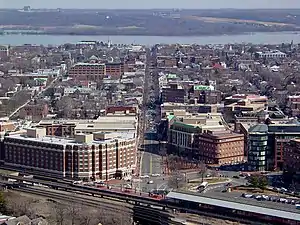 Alexandria |
159,428 | 6,216,589 | |
 Allentown |
125,845 | 861,889 | |
 Atlanta |
498,044 | 5,949,951 | |
 Augusta |
196,939 | 600,151 | |
 Baltimore |
602,495 | 2,802,789 | |
.jpeg.webp) Boston |
694,583 | 4,628,910 | |
 Bridgeport |
144,900 | 939,904 | |
 Charleston |
136,208 | 802,122 | |
 Charlotte |
872,498 | 2,636,883 | |
_-_exterior_2.jpg.webp) Chesapeake |
244,835 | 1,672,319 | |
 Columbia, MD |
103,467 | 6,216,589 | |
 Columbia, SC |
133,451 | 838,433 | |
 Coral Springs |
133,507 | 5,762,717 | |
 Durham |
264,310 | 2,106,463 | |
 Edison |
100,693 | 19,979,477 | |
 Elizabeth |
128,885 | 19,979,477 | |
Fayetteville |
211,657 | 526,719 | |
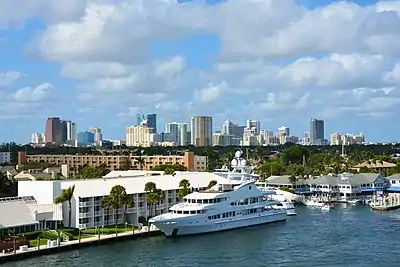 Fort Lauderdale |
182,595 | 5,762,717 | |
 Germantown |
90,494 | 6,216,589 | |
 Greenville |
70,635 | 920,477 | |
 Hampton |
134,510 | 1,672,319 | |
.JPG.webp)
|
122,105 | 1,211,324 | |
 Hialeah |
238,942 | 5,828,191 | |
 Hollywood |
154,823 | 5,762,717 | |
 Jacksonville |
903,889 | 1,523,615 | |
Jersey City |
265,549 | 19,979,477 | |
.jpg.webp) Miami |
470,914 | 6,158,824 | |
 Miami Gardens |
113,069 | 5,762,717 | |
 Miramar |
140,823 | 5,762,717 | |
 New Haven |
130,418 | 862,477 | |
 New York City |
8,398,748 | 19,979,477 | |
Newark |
282,090 | 19,979,477 | |
 Newport News |
179,225 | 1,672,319 | |
 Norfolk |
244,076 | 1,672,319 | |
 Orlando |
285,713 | 2,387,138 | |
.jpg.webp) Palm Bay |
114,194 | 543,376 | |
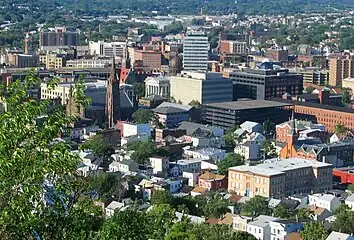 Paterson |
145,627 | 19,979,477 | |
 Pembroke Pines |
172,374 | 5,762,717 | |
 Philadelphia |
1,584,138 | 6,096,120 | |
_(cropped).jpg.webp) Pittsburgh |
302,971 | 2,370,930 | |
 Pompano Beach |
111,954 | 5,762,717 | |
 Portland |
66,417 | 538,500 | |
_up_the_Elizabeth_River%252C_past_Portsmouth_landmarks.jpg.webp) Portsmouth |
94,632 | 1,672,319 | |
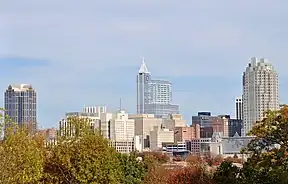 Raleigh |
469,298 | 1,337,331 | |
 Port St. Lucie |
195,248 | 438,095 | |
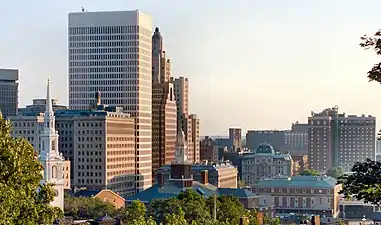 Providence |
179,335 | 1,604,291 | |
 Richmond |
228,783 | 1,260,029 | |
 Savannah |
145,862 | 389,494 | |
 |
153,606 | 631,982 | |
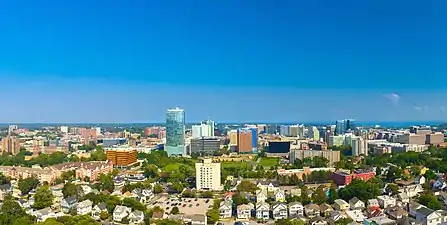 Stamford |
129,775 | 916,829 | |
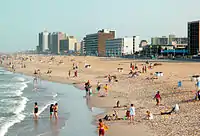 Virginia Beach |
450,138 | 1,725,246 | |
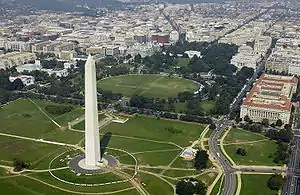 Washington, D.C. |
705,749 | 6,216,589 | |
 West Palm Beach |
111,398 | 5,762,717 | |
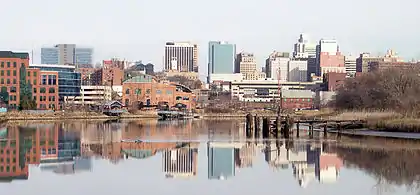 Wilmington, DE |
70,635 | 6,069,875 | |
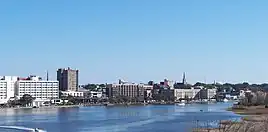 Wilmington, NC |
122,607 | 282,573 | |
 Woodbridge |
100,450 | 19,979,477 | |
Transportation

The primary Interstate Highway along the East Coast is Interstate 95, completed in 2018,[10][11] which replaced the historic U.S. Route 1 (Atlantic Highway), the original federal highway that traversed all East Coast states, except Delaware.[12]
By water, the East Coast is connected from Boston, Massachusetts to Miami, Florida, by the Intracoastal Waterway, also known as the East Coast Canal, which was completed in 1912.[13][14] Amtrak's Downeaster and Northeast Regional offer the main passenger rail service on the Seaboard. The Acela Express offers the only high-speed rail passenger service in the Americas. Between New York and Boston the Acela Express has up to a 54% share of the combined train and air passenger market.[15][16]
Some of the largest airports in the United States are located along the East Coast of the United States, such as John F. Kennedy International Airport in Queens, New York City, Logan International Airport in Boston, Newark Liberty Airport in Newark, New Jersey, Philadelphia International Airport in Philadelphia, Baltimore–Washington International Airport near Baltimore, Dulles International Airport near Washington, D.C., Hartsfield–Jackson International Airport in Atlanta, Miami International Airport in Miami, Charlotte Douglas International Airport in Charlotte, North Carolina, Tampa International Airport in Tampa, and Orlando International Airport in Orlando, Florida.
Culture


As the first spot in the United States that immigrants arrived and the close proximity of Europe, the Caribbean, and Latin America, the East Coast is home to a diverse population and home to multi-cultures when compared to the rest of the US. From the strong Latin culture in southern Florida, to the 200-year-old Gullah culture of the low country coastal islands of Georgia and South Carolina, to the many historic cities in the Middle Atlantic where a strong English, German, Italian, Irish, and French culture are present, the East Coast is significantly more diverse than the rest of the United States. Numerous Chinatowns in New York City, and Little Havana in Miami, are examples of such cultural centers in the bigger cities.
The East Coast is home to much of the political and financial power of the United States, as well as the center for resort and travel destinations in the United States. New York City is the most populous city in the country and a major world financial center. Seventy-one of the world's Fortune 500 companies have their corporate headquarters in New York City, while Midtown Manhattan with 400 million square feet of office space in 2018, is the largest central business district in the world. Washington, D.C. is the capital and political nerve center of the United States. Many organizations such as defense contractors, civilian contractors, nonprofit organizations, lobbying firms, trade unions, industry trade groups and professional associations have their headquarters in or near Washington, D.C., in order to be close to the federal government.
Miami is one of the top domestic and international travel destinations in the United States. Miami is the warmest major city in the continental United States in winter, which contributes to it being a major tourism hub for international visitors. Miami has one of the largest concentrations of international banks in the United States, and the third-tallest skyline in the U.S. with over 300 high-rises, 55 of which exceed 490 ft (149 m). The Port of Miami is the busiest cruise port in the world in both passenger traffic and cruise lines, with over 5.5 million cruise passengers passing through the port each year. The center for tropical plant culture and research in the United States is based in Miami at Fairchild Tropical Botanic Garden. The state of Florida is the second-largest producer of oranges in the world behind Brazil.
See also
Notes
- Those colonies were New Hampshire, Massachusetts Bay, Rhode Island and Providence Plantations, Connecticut, New York, New Jersey, Pennsylvania, Delaware, Maryland, Virginia, North Carolina, South Carolina and Georgia. While Pennsylvania is not directly along the Atlantic shoreline, it borders the tidal portion of the Delaware River and the city of Philadelphia was a major seaport.
References
- "East Coast States 2020". Archived from the original on April 12, 2020. Retrieved April 12, 2020.
- East Coast Region Energy Sector Risk Profile (PDF), US Department of Energy Office of Electricity Delivery & Energy Reliability, retrieved June 7, 2023
- "Seaboard". Collins Dictionary. HarperCollins. Retrieved September 22, 2022.
- General Reference Map Archived October 17, 2012, at the Wayback Machine, National Atlas of the United States, 2003.
- "1500-1667 Contact & Conflict". Maine History Online. Archived from the original on September 19, 2018. Retrieved September 21, 2018.
- "A Brief History - Florida Department of State". www.flheritage.com. Archived from the original on October 30, 2012. Retrieved November 6, 2012.
- Neal Dorst. "Frequently Asked Questions: When is hurricane season?". Hurricane Research Division, NOAA. Archived from the original on May 6, 2009. Retrieved March 14, 2016.
- Gabler, Robert E.; Petersen, James F.; Trapasso, L. Michael; Sack, Dorothy (2008). Physical Geography. Cengage Learning. p. 575. ISBN 978-0495555063. Archived from the original on March 15, 2017. Retrieved March 14, 2016.
- 2010 Census: Resident Population Data Archived October 19, 2013, at the Wayback Machine
- Griffin, Riley (August 20, 2018). "After 60 Years, I-95 Is Complete". Bloomberg.com. Archived from the original on October 11, 2018. Retrieved January 20, 2019.
- Geewax, Marilyn (August 20, 2010). "Starting A Journey On I-95, The Road Most Traveled" (transcript). NPR.org. National Public Radio. Archived from the original on July 30, 2018. Retrieved July 30, 2018.
- "U.S. 1: Fort Kent, Maine to Key West, Florida". Federal Highway Administration, U.S. Department of Transportation. April 7, 2011. Archived from the original on March 4, 2016. Retrieved March 14, 2016.
- Reiley, Laura (2008). Florida Gulf Coast. Moon Handbooks. p. 373. ISBN 9781598800821.
- Maurice J. Robinson (2008). Ponte Vedra Beach: A History. p. 89. ISBN 9781596294417.
- Nixon, Ron (August 15, 2012). "Air Travel's Hassles drive riders to Amtrak's Acela". The New York Times. Archived from the original on July 22, 2016. (for Acela express passenger numbers only)
- "The Information: Most popular airline routes". Financial Times. January 17, 2009. Archived from the original on January 21, 2009. Retrieved February 2, 2010.